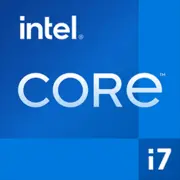Intel Core i7-12650HX

インテル Core i7-12650HX: プロフェッショナルとゲーマーのためのモバイルパワー
2025年3月
インテル Core 12世代プロセッサーは、i7-12650HXモデルを含む重要なステップで、モバイルCPUの進化を遂げました。新しい世代(例えば、Meteor LakeやLunar Lake)の登場にもかかわらず、このモデルは高性能ノートパソコンのセグメントで人気を保っています。2025年にi7-12650HXがどのようなユーザーに向いているのか、どのようなタスクを処理できるのか見てみましょう。
1. アーキテクチャとプロセステクノロジー: アルダーレイクのハイブリッドアプローチ
i7-12650HXプロセッサーは、ハイブリッドアーキテクチャのアルダーレイク(インテル7プロセス、以前は10nm Enhanced SuperFinとして知られている)を基に構築されています。これは、Performance-cores (P-cores) と Efficient-cores (E-cores) を組み合わせたインテル初のデザインです。
- コアとスレッド: 14コア(6 P-cores + 8 E-cores)および20スレッド。P-coresは基本周波数2.3GHzで、ターボブースト時には4.7GHzまで達します。E-coresは最大3.4GHzで動作します。
- キャッシュ: 24MB L3キャッシュは、複雑なタスク(例えば、3Dシーンのレンダリング)を処理するのに十分です。
- 統合グラフィックス: インテル UHD Graphics 12世代(96 EU、1.45GHz)。オフィス作業や4K動画再生には適していますが、ゲームや編集にはディスクリートグラフィックスカードが必要です。
アーキテクチャの特徴:
- Thread Director — P-coreとE-coreの間でタスクを分配するアルゴリズム。たとえば、ゲームやPhotoshopはP-coresで自動的に実行され、バックグラウンドプロセスはE-coresで処理されます。
- DDR5-4800およびPCIe 5.0のサポート — 高速なNVMeストレージや将来のグラフィックスカードに対応しています。
2. TDP 55W: パフォーマンスと発熱のバランス
プロセッサーの公称TDPは55Wですが、ターボモードでは消費電力が157Wに達することがあります。これには効果的な冷却システムが必要です。
- コンパクトなノートパソコン(例えば15インチのウルトラブック)では、i7-12650HXは過熱を避けるために低い周波数で動作することがしばしばあります。
- 大型クーラーを搭載したゲーミングモデル(MSI GP76、ASUS ROG Strix)では、プロセッサーは負荷時に高い周波数を維持し、そのポテンシャルを引き出します。
省電力技術:
- Intel Dynamic Tuning 2.0 — 負荷に応じて動的に電力を調整します。
- Speed Shift — バッテリーを節約するためにプロセッサー間の状態を即座に切り替えます。
3. パフォーマンス: オフィスから4Kレンダリングまで
オフィスとマルチメディア
- PCMark 10テスト: 6500ポイント。i7-12650HXを搭載したノートパソコンは、Chromeで50以上のタブを開いた状態やストリーミング動画、ドキュメント編集を簡単にこなします。
- Adobe Photoshop: RAWファイルの処理(50MP)は1.5〜2秒で完了します。
ゲーム
ディスクリートグラフィックスカード(例えば、NVIDIA RTX 4060またはAMD RX 7600M XT)を搭載した場合:
- Cyberpunk 2077 (1440p, Ultra): DLSSを使用して60〜65 FPS。
- Fortnite (1080p, Epic): 120〜140 FPS。
ターボモード:
Cinebench R23ベンチマークでは、プロセッサーは14500ポイントを出します(マルチスレッドモード)。ただし、5分後にはP-coresの周波数が4.1GHzに低下することがあります。このため、プロフェッショナルなアプリケーションでの安定した動作には高品質なクーラーが必要です。
4. 使用シナリオ: i7-12650HXは誰に向いている?
- ゲーマー: RTX 4070以上のカードと組み合わせることでQHDゲームが可能。
- クリエイティブプロフェッショナル: DaVinci Resolveでの動画編集、Blenderでの3Dモデリング。
- エンジニア: コードのコンパイル、CADプロジェクト(SolidWorks、AutoCAD)。
向いていない人:
- 自律性(8時間以上)が重要なユーザー。
- ウェブアプリやオフィス作業のみに従事する人 — ここではi5やRyzen 5で十分。
5. 自律性: パフォーマンスの代償
アクティブな使用(ゲーム、レンダリング)時に、i7-12650HX搭載ノートパソコンはバッテリーで2〜3時間動作します。省電力モード(明るさ50%、オフィス作業)では6時間まで可能です。
使用時間を延ばす方法:
- Windowsの「バッテリー節約」モードを有効にする。
- ThrottleStopなどのユーティリティを使用してターボモードをオフにする。
- 90Wh以上のバッテリーを搭載したモデルを選ぶ。
6. 競合他社との比較
- AMD Ryzen 7 7840HS(Zen 4, 8コア/16スレッド): マルチスレッドのタスク(例えば、レンダリング)では優れていますが、シングルスレッド(ゲーム)では劣ります。
- Apple M3 Pro(12コア): 30%エネルギー効率が良いですが、Windowsプログラムとの互換性は限られています。
- Intel Core i7-13700H(Raptor Lake): ゲームでは10〜15%高速ですが、価格が高いため注意が必要です。
価格: 2025年にi7-12650HXを搭載したノートパソコンは$1100〜$1600で提供されます(例:Lenovo Legion Pro 5 — $1300、Acer Predator Helios 300 — $1500)。
7. 長所と短所
強み:
- ゲームとプロフェッショナルアプリケーションでの高いパフォーマンス。
- DDR5およびPCIe 5.0のサポート。
- Windows 11向けに最適化されています。
弱み:
- 負荷時の高温。
- 短いバッテリー駆動時間。
- 統合グラフィックスはAMD Radeon 780Mよりも劣る。
8. ノートパソコン選びのおすすめ
- ゲーミングモデル: 最低でも16GB DDR5、SSD 1TB、RTX 4060/4070。例:MSI Katana 15($1200から)。
- ワークステーション: 正確な色再現が可能なディスプレイ(100% sRGB)、Thunderbolt 4ポート。例:Dell Precision 5570($1800から)。
- 汎用ノートパソコン: 16:10のディスプレイ、2kg未満の重さ。例:ASUS Vivobook Pro 16X($1400から)。
注目すべき点:
- ファンの数(できれば二つか三つ)。
- RAMとSSDのアップグレードが可能か。
9. 総評
2025年のインテル Core i7-12650HXは、モバイルワークステーションやゲーミングノートパソコンを必要とする人々に最適な選択です。主な利点は次のとおりです:
- ゲームやプロフェッショナルなタスクに対するパワー。
- 新しいメモリとストレージの標準に対する互換性。
しかし、短いバッテリー寿命や騒音のあるクーラーなど、妥協が必要です。静音性や長時間のバッテリー駆動が重要な方は、AMD Ryzen 7 7840UやApple MacBook ProのM3を検討してください。
基本
CPUの仕様
メモリ仕様
GPUの仕様
その他
ソーシャルメディアで共有する
または当サイトへのリンクを追加
<a href="https://cputronic.com/ja/cpu/intel-core-i7-12650hx" target="_blank">Intel Core i7-12650HX</a>